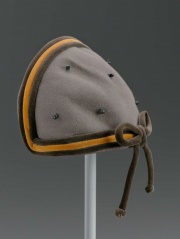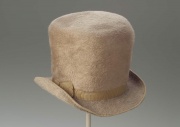Difference between revisions of "Felt"
| (5 intermediate revisions by the same user not shown) | |||
| Line 20: | Line 20: | ||
{| class="wikitable" | {| class="wikitable" | ||
|- | |- | ||
| − | ! Property | + | ! '''Property''' |
| + | ! '''Fiber Composition''' | ||
| + | ! '''Texture''' | ||
| + | ! '''Durability''' | ||
| + | ! '''Collection Risks''' | ||
| + | ! '''Personal Risks''' | ||
| + | ! <small>Recorded tests<br>Brand name: number (dates)<br>See note below.</small> | ||
| + | |- | ||
! 100% Wool Felt or Wool Blend | ! 100% Wool Felt or Wool Blend | ||
| + | | 100% [[wool]] (often [[Merino]])<br>Wool with Rayon or Acrylic | ||
| + | | Soft, smooth, matte appearance | ||
| + | | Very durable, resists pilling | ||
| + | | Water-repellent; degrades in warm, moist environments, attracts insects | ||
| + | | Can cause allergies | ||
| + | | | ||
| + | |- | ||
! Cotton Felt | ! Cotton Felt | ||
| + | | 100% [[Cotton|Cotton]] | ||
| + | | Very soft, warm, stretchy | ||
| + | | Less durable, can pill and fuzz | ||
| + | | Very absorbent for water and vapors; breathable; biological growth | ||
| + | | Hypoallergenic, combustible | ||
| + | | <small>* Acoustic Textile felt (70% cotton): 1 (2019)</small> | ||
| + | |- | ||
! Rayon/Viscose felt | ! Rayon/Viscose felt | ||
| + | | regenerated cotton | ||
| + | | Soft, smooth with silky feel and sheen, good drape | ||
| + | | Less durable, prone to tearing, can shrink and wrinkle | ||
| + | | Like cotton; absorbent; breathable; biological growth | ||
| + | | Hypoallergenic, combustible | ||
| + | | | ||
| + | |- | ||
! Acrylic Felt | ! Acrylic Felt | ||
| + | | 100% [[Acrylic fiber|Acrylic]] fibers | ||
| + | | Can be fuzzy or hard, slightly shiny | ||
| + | | Less durable, can pill and fuzz | ||
| + | | Not water-repellent; sensitive to UV and moisture | ||
| + | | Hypoallergenic, combustible | ||
| + | | <small>* World of Fabrics Acrylic Prefelt: 1(2010)<br>* Buffalo felt: none<br>* Kunin Felt: none</small> | ||
| + | |- | ||
! Polyester Felt | ! Polyester Felt | ||
| + | | 100% [[Polyester fiber|Polyester]] fibers | ||
| + | | Slightly fuzzy, soft surface | ||
| + | | Durable, resists tearing and fraying | ||
| + | | Water-resistant; sensitive to UV and heat; absorb oils | ||
| + | | Hypoallergenic | ||
| + | | <small>* Benchmark polyester felt: 18 (1999-2018)<br>* Sutherland felt: 10 (2017-2019)<br>* Severnside Fabrics Polyfelt: 6 (2012)<br>* McMaster-Carr Polyester felt: 1 (2019)<br>* Macflex Mac 9 felt: 2 (2008)<br>* University Products Polyfelt: 1 (2017)</small> | ||
| + | |- | ||
! Polypropylene Felt | ! Polypropylene Felt | ||
| + | | 100% [[Polypropylene fiber|Polypropylene]] fibers | ||
| + | | Can be smooth to fuzzy | ||
| + | | Durable, resists tearing and fraying | ||
| + | | Water-repellent; sensitive to UV and heat; absorb oils | ||
| + | | Hypoallergenic | ||
| + | | <small>* Severnside Fabrics Polyfelt: 4 (2009)<br>* McMaster-Carr Polypropylene felt: none<br>* TenCate Geosynthetics: none<br>* Propex: none<br>* Fibertex: none</small> | ||
| + | |- | ||
! Polyaramide Felt | ! Polyaramide Felt | ||
| − | |||
| − | |||
| − | |||
| − | |||
| − | |||
| − | |||
| − | |||
| − | |||
| 100% [[Aramid fiber|Aramid]] fibers | | 100% [[Aramid fiber|Aramid]] fibers | ||
| − | |||
| − | |||
| − | |||
| − | |||
| − | |||
| − | |||
| − | |||
| − | |||
| Soft, non-abrasive | | Soft, non-abrasive | ||
| − | |||
| − | |||
| − | |||
| − | |||
| − | |||
| − | |||
| − | |||
| − | |||
| Very strong, will no tear but may snag | | Very strong, will no tear but may snag | ||
| − | |||
| − | |||
| − | |||
| − | |||
| − | |||
| − | |||
| − | |||
| − | |||
| Resistant to water, fire and biological growth | | Resistant to water, fire and biological growth | ||
| − | |||
| − | |||
| − | |||
| − | |||
| − | |||
| − | |||
| Hypoallergenic | | Hypoallergenic | ||
| − | | | + | | <small>* Nomex felt: 2(2009-2020)<br>* McMaster-Carr Nomex felt: none</small> |
| − | |||
| − | |||
| − | |||
| − | |||
| − | |||
| − | |||
| − | |||
| − | |||
| − | |||
| − | |||
|} | |} | ||
| + | Note: The [https://www.conservation-wiki.com/wiki/Project:Combined_Materials_Testing_Results_(Search_Builder) AIC Materials Testing Results page] provides information on Oddy tests that were completed on these materials. Access their database, then the search box to locate material of interest. | ||
== Resources and Citations == | == Resources and Citations == | ||
Latest revision as of 13:55, 17 February 2025
Description
A nonwoven textile composed of matted Cotton, Wool, or Hair fibers matted together with through mechanical, chemical, or thermal processes, such as heat and moisture. The oldest known fabric samples, excavated in Turkey, are made of wool felt and date to at least 6500 BCE. Felt was usually made from sheep's wool, Goat hair, or Camel hair. Occasionally vegetable fibers (e.g., Cotton, Kapok), rags, recycled paper or synthetic fibers are used for felt. Felt is a good insulator for both temperature and noise. It has been used to make hats, blankets, rugs, insulation, filtration, polishing cloths, and absorbent cloths, as well as to line boxes and instrument cases. Synthetic fibers used for felting include acrylic, polyaramide (Nomex), polyester, polypropylene and Rayon. See also Polypropylene felt, Polyester felt and Acrylic felt.
Synonyms and Related Terms
fur felt; wool felt; polyfelt (for synthetics); Filz (Deut.); feutre (Fr.); vilt (Ned.); fieltro (Esp.)
Applications
- Blankets, hats, rugs, table cloths, placemats
- Insulation, filtration, geotextiles
- Polishing cloths, absorbent cloths
- Protective liners, padding, fillers
- Crafts, toys, decorations
Properties
| Property | Fiber Composition | Texture | Durability | Collection Risks | Personal Risks | Recorded tests Brand name: number (dates) See note below. |
|---|---|---|---|---|---|---|
| 100% Wool Felt or Wool Blend | 100% Wool (often Merino) Wool with Rayon or Acrylic |
Soft, smooth, matte appearance | Very durable, resists pilling | Water-repellent; degrades in warm, moist environments, attracts insects | Can cause allergies | |
| Cotton Felt | 100% Cotton | Very soft, warm, stretchy | Less durable, can pill and fuzz | Very absorbent for water and vapors; breathable; biological growth | Hypoallergenic, combustible | * Acoustic Textile felt (70% cotton): 1 (2019) |
| Rayon/Viscose felt | regenerated cotton | Soft, smooth with silky feel and sheen, good drape | Less durable, prone to tearing, can shrink and wrinkle | Like cotton; absorbent; breathable; biological growth | Hypoallergenic, combustible | |
| Acrylic Felt | 100% Acrylic fibers | Can be fuzzy or hard, slightly shiny | Less durable, can pill and fuzz | Not water-repellent; sensitive to UV and moisture | Hypoallergenic, combustible | * World of Fabrics Acrylic Prefelt: 1(2010) * Buffalo felt: none * Kunin Felt: none |
| Polyester Felt | 100% Polyester fibers | Slightly fuzzy, soft surface | Durable, resists tearing and fraying | Water-resistant; sensitive to UV and heat; absorb oils | Hypoallergenic | * Benchmark polyester felt: 18 (1999-2018) * Sutherland felt: 10 (2017-2019) * Severnside Fabrics Polyfelt: 6 (2012) * McMaster-Carr Polyester felt: 1 (2019) * Macflex Mac 9 felt: 2 (2008) * University Products Polyfelt: 1 (2017) |
| Polypropylene Felt | 100% Polypropylene fibers | Can be smooth to fuzzy | Durable, resists tearing and fraying | Water-repellent; sensitive to UV and heat; absorb oils | Hypoallergenic | * Severnside Fabrics Polyfelt: 4 (2009) * McMaster-Carr Polypropylene felt: none * TenCate Geosynthetics: none * Propex: none * Fibertex: none |
| Polyaramide Felt | 100% Aramid fibers | Soft, non-abrasive | Very strong, will no tear but may snag | Resistant to water, fire and biological growth | Hypoallergenic | * Nomex felt: 2(2009-2020) * McMaster-Carr Nomex felt: none |
Note: The AIC Materials Testing Results page provides information on Oddy tests that were completed on these materials. Access their database, then the search box to locate material of interest.
Resources and Citations
- M.E.Burkett, "Felt" The Dictionary of Art Vol. 10, Grove's Publishing Inc., New York, 1996.
- Fairchild's Dictionary of Textiles, Phyllis G.Tortora, Robert S. Merkel (eds.), Fairchild Publications, New York City, 7th edition, 1996
- The Dictionary of Paper, American Paper Institute, New York, Fourth Edition, 1980
- E.J.LaBarre, Dictionary and Encyclopedia of Paper and Paper-making, Swets & Zeitlinger, Amsterdam, 1969
- The Dictionary of Art, Grove's Dictionaries Inc., New York, 1996 Comment: "Felt" M.E. Burkett
- Wikipedia: Felt (Accessed Nov. 29, 2005 and Feb. 2025)
- Hoechst Celanese Corporation, Dictionary of Fiber & Textile Technology (older version called Man-made Fiber and Textile Dictionary, 1965), Hoechst Celanese Corporation, Charlotte NC, 1990
- Matt Roberts, Don Etherington, Bookbinding and the Conservation of Books: a Dictionary of Descriptive Terminology, U.S. Government Printing Office, Washington DC, 1982
- Dictionary of Building Preservation, Ward Bucher, ed., John Wiley & Sons, Inc., New York City, 1996
- Edward Reich, Carlton J. Siegler, Consumer Goods: How to Know and Use Them, American Book Company, New York City, 1937
- Art and Architecture Thesaurus Online, http://www.getty.edu/research/tools/vocabulary/aat/, J. Paul Getty Trust, Los Angeles, 2000

